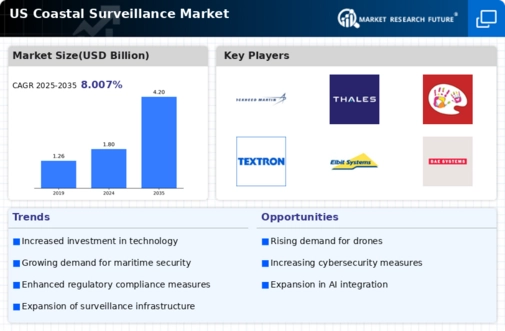Public-Private Partnerships
Public-private partnerships are emerging as a vital driver for the coastal surveillance market. Collaboration between government agencies and private sector companies is fostering innovation and resource sharing. These partnerships enable the development of advanced surveillance technologies that can be deployed more efficiently. The coastal surveillance market is likely to see increased investment from private entities, which could enhance the overall capabilities of surveillance systems. As these collaborations expand, they may lead to a more integrated approach to coastal security, potentially increasing market growth by 4% annually. This trend highlights the importance of collective efforts in addressing coastal challenges.
Rising Maritime Security Concerns
The coastal surveillance market is experiencing growth due to increasing maritime security concerns in the US. With the rise in illegal activities such as smuggling, human trafficking, and piracy, there is a pressing need for enhanced surveillance systems. The US government has recognized these threats and is investing in advanced technologies to monitor coastal areas effectively. According to recent data, the market is projected to grow at a CAGR of 6.5% from 2025 to 2030, indicating a robust demand for surveillance solutions. This trend suggests that stakeholders in the coastal surveillance market must innovate and adapt to meet the evolving security landscape.
Regulatory Compliance and Standards
Regulatory compliance is becoming increasingly important in the coastal surveillance market. The US government is implementing stricter regulations regarding maritime activities, necessitating the adoption of advanced surveillance systems to ensure compliance. Companies operating in this space must invest in technologies that meet these regulatory standards, which could drive market growth. The coastal surveillance market will expand as organizations seek to avoid penalties and enhance operational efficiency. With the market projected to grow by 5.5% over the next five years, adherence to regulations will likely play a crucial role in shaping the future landscape of coastal surveillance.
Environmental Monitoring Initiatives
Environmental monitoring is becoming a critical driver for the coastal surveillance market. The US government is increasingly focused on protecting marine ecosystems and addressing climate change impacts. Surveillance systems are essential for monitoring water quality, tracking marine life, and detecting illegal fishing activities. The coastal surveillance market will benefit from initiatives aimed at preserving biodiversity and ensuring sustainable practices. As environmental regulations tighten, the demand for sophisticated monitoring solutions is expected to rise, potentially leading to a market growth of 5% annually. This trend underscores the importance of integrating environmental considerations into coastal surveillance strategies.
Technological Integration in Defense
The integration of advanced technologies in defense applications is significantly influencing the coastal surveillance market. The US military is adopting cutting-edge technologies such as artificial intelligence, machine learning, and unmanned systems to enhance situational awareness along the coastlines. This shift is likely to drive demand for innovative surveillance solutions that can process vast amounts of data in real-time. The coastal surveillance market is projected to reach a valuation of $3 billion by 2030, reflecting the increasing reliance on technology for national security. This trend indicates a growing intersection between defense needs and commercial surveillance capabilities.




















Leave a Comment